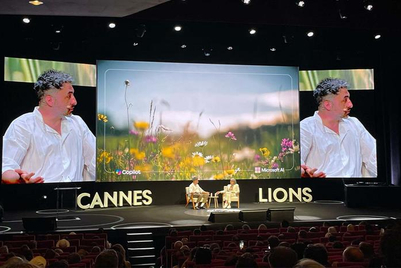
US game developer Roblox Corporation’s acquisition of Guilded, the online platform for people to come together and communicate in meaningful ways, is further proof that the metaverse – a world in which the digital and physical are blurred – is having a bit of a moment.
It should also be a wake-up call for every brand.
True, Roblox Corporation’s eponymous Roblox game was the highest-grossing game across the App Store and Google Play this July. And yes, Guilded – a competitor to the more famous Discord – was originally conceived as a platform to unite online gaming communities.
Yet Roblox’s ambition beyond gaming – demonstrated by Party Place, the virtual hangout space it launched in response to the pandemic – and Guilded’s voice chat, video chat and integrated calendar and scheduling tools point to something else.
A significant acceleration of the evolution beyond gaming of online tools that enable anyone to imagine, create, have fun with friends, work – even campaign – in an immersive, interactive, virtual space is now heralded by Roblox and Guilded’s coming together.
Interest in the metaverse, a term first coined in Neal Stephenson’s 1992 novel Snow Crash (then closely associated with gaming), has grown significantly over the past 18 months. The pandemic crisis forced all brands to adapt at speed last year, as lockdown measures forced many of us to conduct much of daily life – from work to entertainment, and shopping to social interaction – online via screens.
Consumers moved dramatically to online channels; food and household categories recorded an average of more than 30% growth in online customer base across 45 countries, according to one survey. Brand owners, meanwhile, created and evolved their digital offerings, fast.
It comes as no surprise, then, that, during the height of the pandemic crisis, the most successful organisations were those with a range of technology-related capabilities found lacking in their competitors.
Now, following a summer in which Burberry launched its first digital product (a non-fungible token collection) and even Visa dipped its toe (by buying a piece of digital art), the world is navigating its way into a new living-with-Covid normal: a sort of phygital space of mixed behaviours, subject to change at any moment.
As all organisations weigh up how best to balance these digital and physical interactions at a time when people have adjusted to doing more digitally (yet can now get back out and do more face to face), brands face a watershed moment. The inflection point they have now reached presents both big challenges and major opportunities that they must navigate by addressing three very important challenges.
The first is deciding what role digital should now play in their strategy to ensure their recent increased digital investment is not wasted, and that any future investment both plays to a brand’s strengths and meets a brand owner’s business goals.
To address this, brands must ensure marketing campaigns are planned with a digital thread that spans all platforms and interactions, making sure that their messaging is consistent throughout. To achieve this goal, it has never been more important to integrate digital experiences into physical spaces.
This means recognising the benefits unlocked by the metaverse, how a digital space can supercharge a brand experience, and designing the physical brand-to-consumer interaction to leverage these possibilities rather than approaching that component as an add-on.
A case in point is the new Browns luxury boutique.
This store of the future recently launched by Farfetch in London deploys digital technology – connected mirrors, augmented reality virtual try-ons, and high-touch services – to encourage consumers to linger in the physical store for longer and interact with the brand’s online presence in a seamless way.
The second challenge is finding the balance to strike between physical world and digital world communications to best ensure a brand owner optimises and maximises the value it gets from both.
It’s critical that brands move to designing from a "remote first" perspective, prioritising the nascent rise of flexible viewership. This means optimising for the remote audience and not treating it as an afterthought, prioritising bridging the gap between those attending in-person and online to eliminate FOMO among either segment.
A good example of this reconfiguration of physical format to optimise the online experience comes with Jägermeister’s #SavetheNight. The spirits brand launched an online global campaign soon after the first lockdown to help the on-trade during the pandemic with financial aid, and offer artists, creatives and bartenders support.
A year on, despite hospitality re-opening, the company has completely changed its approach to content, optimising all its content (in-person and digital) for online – adjusting content length, for example, and integrating the digital experience into the physical, and vice versa.
The third challenge is how best to cultivate a digital and physical innovation mindset to stay relevant and flexible in a world increasingly characterised by unpredictability and constant change.
To meet this need, brands must design with consistency across all channels to be able to maintain that critical uninterrupted contact between themselves and their consumer, despite any future unexpected shift or change.
They must continue to alter offerings to be more digital/remote-friendly and monitor and seek out new platforms that are building behaviours as the metaverse further evolves. In short, brands need to integrate their digital and physical approach and ensure all interactions via each and between the two are seamless.
Which leads us back to Roblox Corporation, and others with similar aspirations: Epic Games, self-declared “shepherds of the metaverse”, for example. Even Facebook, which recently acquired the developer of Roblox-style platform Crayta and boldly went public with a new goal: to become “a metaverse company”.
Companies like these now describe their mission as being to venture beyond simply building a set of interconnected social apps and hardware, to building a maximalist, interconnected set of experiences operated by many in a decentralised way.
A wake-up call to brands indeed.
Kim Lawrie is head of creative technology at Engine Creative


.jpg&h=334&w=500&q=100&v=20250320&c=1)


.png&h=334&w=500&q=100&v=20250320&c=1)




.png&h=334&w=500&q=100&v=20250320&c=1)



.jpg&h=268&w=401&q=100&v=20250320&c=1)

.png&h=268&w=401&q=100&v=20250320&c=1)
.png&h=268&w=401&q=100&v=20250320&c=1)

